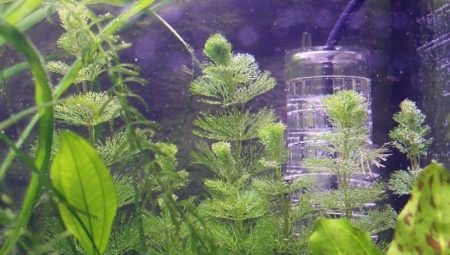Hydrogen peroxide is an affordable and very effective drug used to solve a variety of aquarium problems. This tool helps saturate water with oxygen, get rid of unnecessary vegetation and cure fish of some bacterial and fungal infections. However, you should be extremely careful with peroxide - any increase in the allowable dosage will inevitably lead to the death of aquatic inhabitants.
Operating principle
When hydrogen peroxide enters the water, it begins to decompose into oxygen and hydrogen, thereby enriching the stagnant liquid in the aquarium. At the moment of peroxide interaction with cells and tissues of lower microorganisms, an oxidation reaction occurs, which in many ways contributes to the destruction of undesirable pathogenic flora. The onset of action of the drug can be judged by air bubbles that rise from the bottom of the tank.
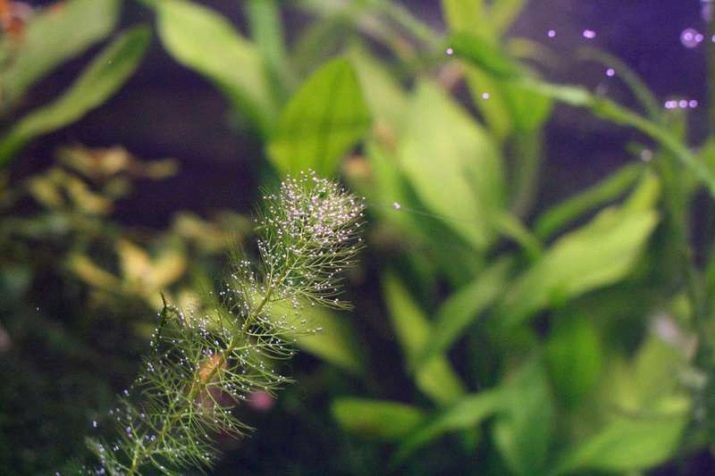
General Terms of Use
We note right away that a 3% hydrogen peroxide solution is used in aquarium farming. The composition has established itself as an effective tool that can fight many diseases, oxygen starvation of aquarium inhabitants, as well as rapidly growing algae. Do not forget that This drug is very strong and aggressive, therefore, when exceeding the recommended concentrations, it is able to simply burn out everything living in an artificial reservoir.
To avoid such adverse effects and instead of treating the fish, do not completely destroy them, peroxide is pre-diluted in a separate container and only then poured into water. Usually, it is diluted 10–20 times before use, and then injected very slowly using a syringe into the filter stream. After 60–90 minutes, the water should be replaced by half - otherwise, the organics dying off under the influence of the drug will begin to rot and poison the water.
Important! If disinfection measures require concentrations in excess of 40 ml per hundred liters of liquid, it is important to provide the most efficient aeration in the aquarium or treat the fish in a separate tank.
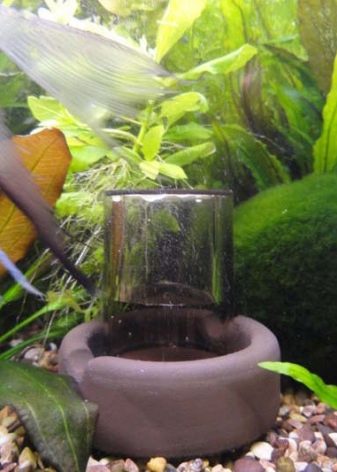
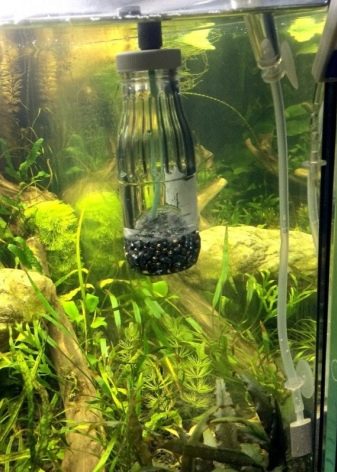
Fish treatment
One of the main problems that fish face is oxygen starvation. It can occur in several cases:
- with low power or complete absence of compressors;
- with increasing water temperature;
- with overpopulation of fish.
In such situations, pets do not have enough oxygen, they begin to suffocate - then hydrogen peroxide becomes a real salvation for all representatives of the aquarium fauna. As a rule, the visible effect of using the product is noticeable already 15–25 minutes after the addition of the treatment solution: the fish quickly come to their senses and begin to swim away from the surface of the water into their shelters. When the artificial reservoir is oversaturated, fish is often poisoned with ammonia contained in the waste products of pets.
Depending on the condition of the fish apply a solution of peroxide in a volume of 1 to 3 ml for every 10 liters of water. From the very first minutes, hydrogen peroxide begins to work, facilitating the breathing of pets and significantly accelerating oxidative processes, as well as stimulating the breakdown of nitrates and their removal from the body. It is no exaggeration to say that agents that act as fast as hydrogen peroxide simply do not exist.
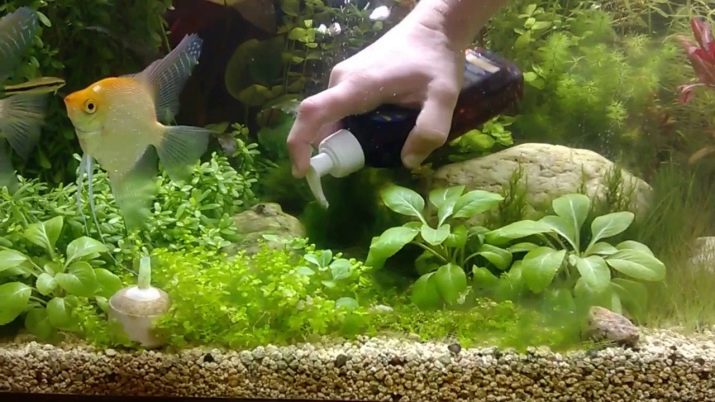
The drug can also be used to treat the following diseases that fish face:
- bacterial infections of the fins and body;
- attack of gills by parasitic microorganisms;
- skin lesions by parasites.
If the problem is insignificant, the disease is at an initial stage, then it is possible to treat fish in a common reservoir. In this case, the proportion of the drug administered is 2.5 mg per 10 liters of water, the procedure is carried out twice a day for a week. If the fish has a severe lesion of the skin, then you can cure it with the help of bathtubs with peroxide, usually such procedures are very easily tolerated by fish. For this, water is poured into a separate tank and fungicide is diluted from the ratio of 1 ml of peroxide to 1 liter of water, and the diseased individual is placed there for 10-15 minutes.
Important! If during treatment the fish feels unwell, treatment should be discontinued.
With severe fin rot, the baths also help, they are carried out in a similar way, only the concentration of the drug is used a little more - 4 ml per 1 liter of water. Processing takes about 30-50 minutes. The treatment of fin rot is carried out twice a day until the fins begin to recover. After this, the therapy is continued in the same way as if the infection was mild, i.e. in a common aquarium.
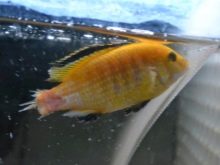
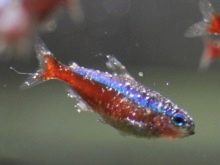
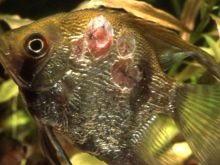
Algae control
Hydrogen peroxide is often used to get rid of overgrown algae. In aquariums with reduced oxygen content, blue-green algae often appears. They multiply very quickly and in the shortest possible time are able to double their mass, while mucus appears on the walls of the tank and on other aquatic plants, all this is accompanied by a sharp unpleasant odor.
Aquariums often suffer from nitchanka - This algae is dark green, almost black in color, which braids water plants, preventing the access of light to them. As a result, they cannot fully grow and develop, in addition, small fish get confused in threads and die. Against blue-white algae and nitchanka, hydrogen peroxide proved to be very good. To combat “uninvited guests”, a solution of 2.5 ml per 10 liters of liquid is poured into the water, the procedure is repeated daily until the algae is completely destroyed, most often the effect is noticeable already on the third day.
A very dangerous algae is considered to be Vietnamese. If she entangled the plant, the treatment will have to be carried out in a separate tank, since only increased concentrations of the reagent will help here. With great care, the affected plant is removed from the soil and placed in a jar with a solution of peroxide, in this case, the dosage is 4 mg per 10 liters.
Processing is carried out for about an hour, then the plant is returned back to the aquarium without rinsing. To achieve the effect, peroxide is introduced into the water in standard concentration. The danger to plants is the black beard. The leaves become covered with a dark coating and gradually die, a similar phenomenon occurs with a large number of food residues in the water and excessive aeration. Hydrogen peroxide is one of the most effective means against this algae, processing is carried out in a concentration of 2–2.5 ml per 10 l of water every day until the aquarium is completely released.
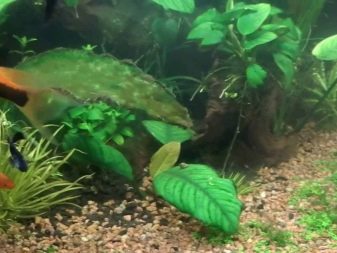
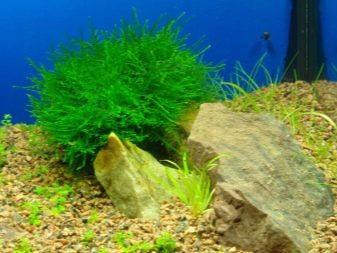
Aquarium disinfection
Hydrogen peroxide in high doses is an excellent antiseptic. It is able to destroy the entire microflora, while it does not require subsequent washing of the inner surface - this is its fundamental difference from most other drugs. If you have whitish worms in an artificial pond, for example, planaria, and also small snails have proliferated excessively, it is urgent to connect “heavy artillery” in the form of peroxide.
Before processing you need to remove from the tank everything that you want to protect - fish, aquatic plants and all kinds of invertebrates. 30–45% perhydrol is poured into the container (we draw attention to the fact that this is not a pharmaceutical 3% solution, but a strong industrial composition) - it must be diluted with water so that a concentration of 4.5–6.5% is formed.
Important! This solution should be worn with gloves, otherwise there is a high risk of severe burns. After the container is processed, all the liquid must be drained, and then the soil must be thoroughly siphoned to destroy the dead organics.

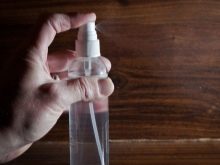
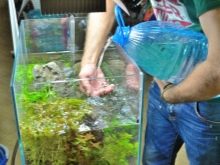
Emergency situations
Hydrogen peroxide is used to disinfect liquids when excess organic matter has accumulated in it. what could be as a result of the following reasonsn:
- with excessive feeding of the inhabitants in the water there are leftover food leftovers that, when decomposed, pollute the aquarium;
- if the breeder accidentally poured out too much feed and did not immediately remove the excess;
- if one or several fish die, if not removed on time, they will begin to decompose and release toxic substances into the water;
- when the filter breaks.
Important! In this situation, first you need to eliminate the source of pollution, replace the water with 30–50%, and then add the reagent at the rate of 1.5–2 mg for every 10 liters of water.
In addition to the cases described above, hydrogen peroxide is also used to incubate eggs - peroxide contributes to the maximum yield of fry and their better development. Many arthropod lovers add a solution for brine shrimp - for faster hatching, they are immersed in a solution of the drug for half an hour.
Do not forget, peroxide is a serious drug, so it is used as a measure of emergency treatment. Its use for preventive purposes is unacceptable.
For what dosage of hydrogen peroxide is needed for an aquarium, see the next video.
